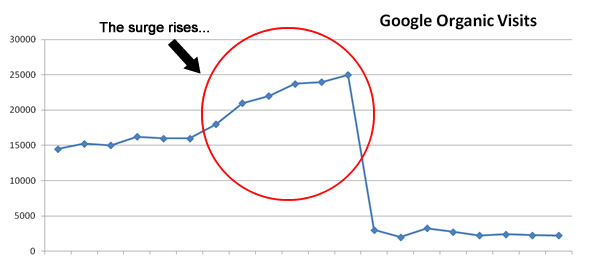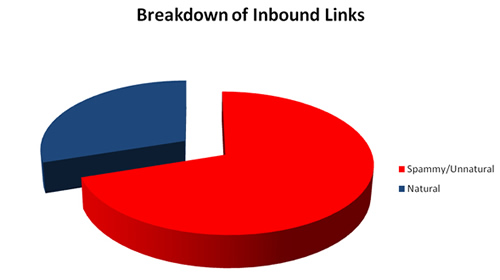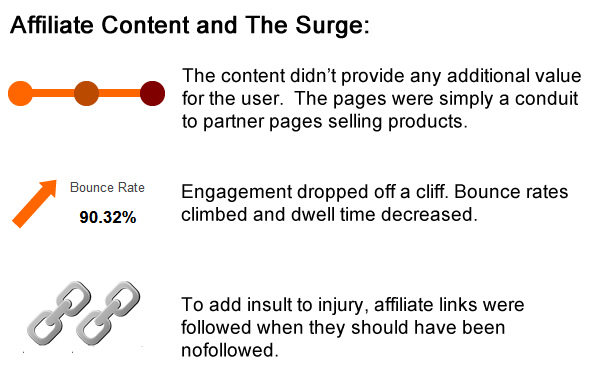
I receive a lot of calls from companies that have been hit by Panda or Penguin, and both algorithm updates have been fascinating to analyze. When I first begin speaking with companies that have been impacted, my goal is to quickly identify exactly what happened over time, so I can begin the process of identifying why the strike occurred.
Although each company has its own history, and story to tell, there’s one element I wanted to cover today that might be able to help you as well. And if you’re saying to yourself, “Glenn’s crazy, our traffic has been surging recently! We have nothing to worry about…”, then you should grab a cup of coffee and read the rest of this post.
Trending Leading up to an Algo Hit
Once I gain access to a client’s analytics reporting and webmaster tools account, I begin analyzing Google organic trending leading up to, and then following, an algorithm update. The drop in traffic can sometimes be catastrophic.
For example, one company that reached out to me from Europe saw a 98.5 percent drop in traffic after getting hit by Penguin. I almost fell out of my seat while reviewing their reporting. And as you can guess, Google organic traffic is how they landed most of their business.
Although it’s easy to focus on the staggering drop in traffic, it’s extremely important (and interesting) to analyze the traffic leading up to a hit due to an algorithm update. What was happening then?
Could the algorithm hit have been predicted by flagging unusual traffic patterns? Were there any signs that a cute, black and white animal was barreling down on them?
Well, for some of the companies I’ve helped, the answer is yes.
Google organic trending could have signaled problems, but unfortunately, the business owners and webmasters didn’t pick up the up the signs (or were misled).
“But it was Going so Well.”
That’s the quote I’ve read and heard a thousand times since February 2011. I’ve also heard, “we got hit out of nowhere”, “we had record traffic levels leading up to the drop”, and “we were ready to expand our business when the drop occurred”. Yes, that surge in traffic was misleading, and I would go even further and say it’s sinister.
Not every site hit by Penguin or Panda has experienced this surge, but several that I have analyzed have seen that surge. And the traffic surge is an important signal that can mean you’re doing your job well, or you’re not. Regardless, it’s important to understand the surge is happening so you can determine what’s really going on.
For most webmasters without a solid understanding of SEO, that surge seems like Google is rewarding them for doing the right things. When in reality, the surge is the data that Google needs to collect in order make a decision (algorithmically).
The webmasters in question had a false sense of security (and empowerment). They made changes, they saw results, and then witnessed a surge in traffic from Google from target keywords. And sometimes, they weren’t just any target keywords, they were the most competitive keywords in the lot.
So, why would a webmaster view that surge in traffic as bad? How would they know that a tsunami was quickly approaching?
The answer lies in understanding the SEO tactics being executed, how those tactics were impacting traffic levels, and how those tactics could damage a website. And that’s where the disconnect occurs.
Here are two examples of trending from sites that experienced a surge before an algorithm hit (one directly from Google Analytics, and one with data exported from Omniture):


Some Possible Causes of the Surge
When it comes to Panda and Penguin, there are many triggers that could cause a site to fall victim. I always explain Panda as a much deeper algorithm update at this stage than Penguin, and there could be a number of reasons a site gets hit by our bamboo-eating friend.
Penguin, on the other hand, is extremely acute (at least until future versions of Penguin roll out that take additional factors into account). I’ve now analyzed more than 160 sites hit by Penguin, and the culprit every time was a horrible link profile.
So, what causes the surge in traffic that I’ve seen across several of the sites hit by Panda or Penguin? The answer is simple. The poor SEO tactics actually worked for a period of time until enough data was available, and until Google rolled out the next algorithm update. And at that point, it was too late.
Some of these companies could have avoided disaster had they noticed the red flags and taken action. Let’s dig into a few of the causes of the surge in traffic. Hopefully it helps you understand why some sites attract Penguins and Pandas.
1. Thin, But Over-Optimized Content
Some companies began churning out a lot of low-quality, thin content that was heavily optimized (from a title tag standpoint). Based on their domain authority, which they built up over years, those sites began ranking for target keywords when the content didn’t deserve to.
As Google sent more traffic, more users bounced off the site as they hit weak pages. As more pages were added over time, and more users left, Google hammered the site during the next Panda update.

Recommendation:
Be neck deep in your reporting. Understand your organic search traffic, including which landing pages are receiving the most traffic, and why.
Yes, ask why those pages are ranking. If some of the companies had asked the question during the surge, and then answered objectively, they would have clearly seen the problem.
Removing those thin pages, or enhancing them, would have been smart, and could have avoided a disastrous drop in traffic. You can read a case study I wrote about a Panda recovery here. There are some important insights in that post that relate to this topic.
2. Building the Wrong Links
OK, you can substitute “spammy”, “risky”, or “unnatural” for “wrong” in the subheading above. Many of the companies hit by Penguin at some point hired an SEO company for link building. They didn’t track the company at a granular basis, but noticed a really nice uptick in rankings and traffic as the company built more links. “We were very happy with the results”, “our core keywords kept rising in the search results”, “business was never better”, etc.
Unfortunately, it only takes a few minutes in Open Site Explorer or Majestic to see the problem. The links being built were all spammy. Tons of directories, article submission sites, comment spam, link networks, etc.
The link building worked in the short-term. Rankings rose, traffic increased, and everyone was happy. That’s until Chilly Willy made a visit and hammered the sites in question.
Note, if you’re interested in learning more about a site hit by Penguin, why it was targeted, and how it recovered, you can read another case study here.

Recommendation:
Know who you are hiring, get references, check the sites they have helped, and check each site’s link profile. The proof is in the pudding.
Continually check your inbound links via Google Webmaster Tools, third party tools, as well as double check reports from the SEO agency helping you. Had the companies struck by Penguin analyzed all of the links being built, and the heavy use of exact match anchor text, they possibly could have addressed the situation while it was happening (and not after losing significant amounts of traffic).
Yes, some of the companies were fully aware of what their SEO agency was doing (and gave approval to do so). I don’t necessarily feel bad if that’s the case, and understanding the links wouldn’t have made a difference.
However, there are companies out there that trusted third parties to build links to help with SEO. In those situations, seeing the actual links could have triggered some questions. And those questions could have halted the process of acquiring more spammy links, which in turn, could have kept the big bad Penguin away.
3. Affiliate Content and Links
Some companies decided to add an affiliate component to their core domains. They had built up strong domain authority and wanted to use that authority to drive organic search traffic to affiliate pages. They figured this would be a quick way to earn some money from their hard-earned SEO strength.
Bad idea.
As the affiliate content was being added (which also included followed links to the partner websites), traffic began to pick up. It makes sense, given the query volume around some of the keywords being targeted, in combination with the domain authority of the sites in question. The combination yielded a surge in traffic that was paying off nicely for the companies.
But, three things were going on that weren’t readily apparent to the business owners.
- The content didn’t answer any questions, solve any problems, or provide any additional value for the user. The pages were simply a conduit to the partner pages where users could buy products.
- Engagement dropped off a cliff. Bounce rates skyrocketed, dwell time was incredibly low, and Google picked up on this.
- The followed affiliate links weren’t helping matters… Affiliate links should be nofollowed. Passing PageRank to affiliates is never a smart idea, and Google isn’t going to react well.

And as you can guess, the sites got hit, and hard. The misleading surge in traffic made everyone involved feel warm and fuzzy. And the additional money coming in from affiliate marketing was icing on the cake. That’s until Panda had a conniption and stomped all over the site, including non-affiliate content (Panda impacted the entire domain).
The pain from the drop forced several of the companies I was helping to lay off employees, revamp their sites, and hope for the best. Some have recovered, but it’s a long and tiring process. Believe me, you don’t want to have to deal with Panda if you don’t have to.
Recommendation:
Don’t use a site that you’ve built up a lot of domain authority in as your affiliate marketing website (when that wasn’t the initial intention of the site). Several of you probably cringed wondering how anyone would do that. But it happens.
The sites are strong, it’s easier to rank with an established site, and business owners end up pulling the trigger. The problem is that it works in the short-term until the mighty Panda pulls his own trigger.
High noon with a Panda doesn’t end well for the cowboy. He finds himself without a horse, without food, and without bullets. That’s until he’s let back into town, often with less power than he had originally.
Summary – The Surge is Sinister
Don’t fall victim to the surge. Understand your site, your efforts, and your traffic levels.
You should know how and why new organic search traffic is hitting your site. And above all, make sure it should be hitting your site in the first place! Because if it shouldn’t, there are several mechanisms that Google can use to understand what’s going on.
Remember, that surge in traffic could reverse itself faster than you can say “Panda” or “Penguin”. And at that point, you won’t have much to look at in your reporting.
Ask questions, do your own detective work, and avoid a major hit. Fear the surge.





